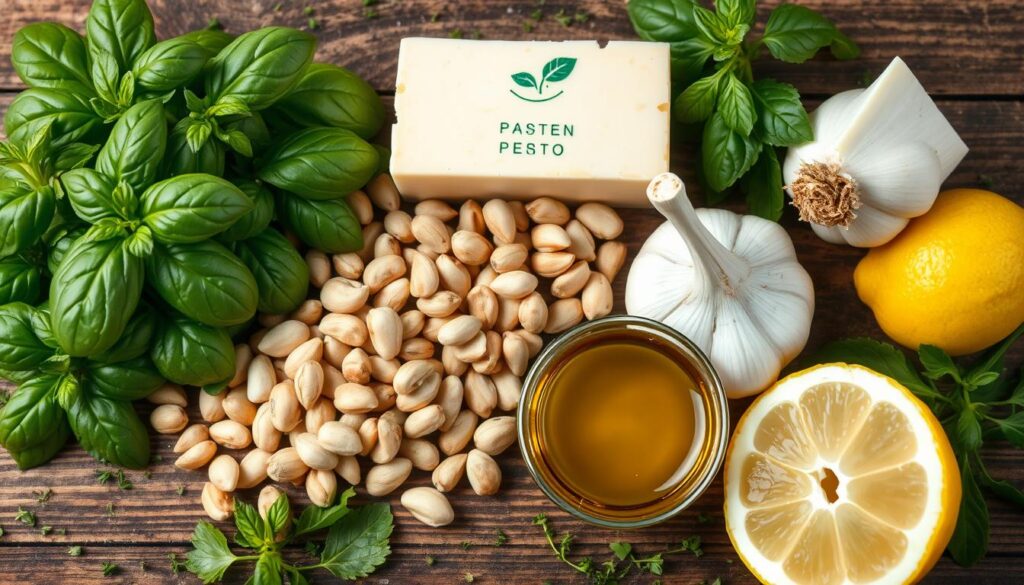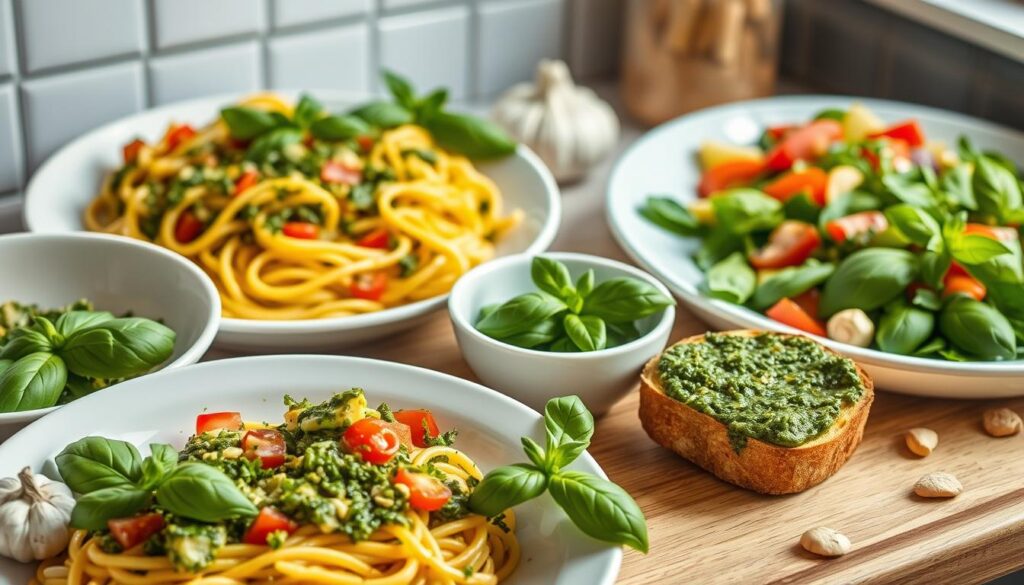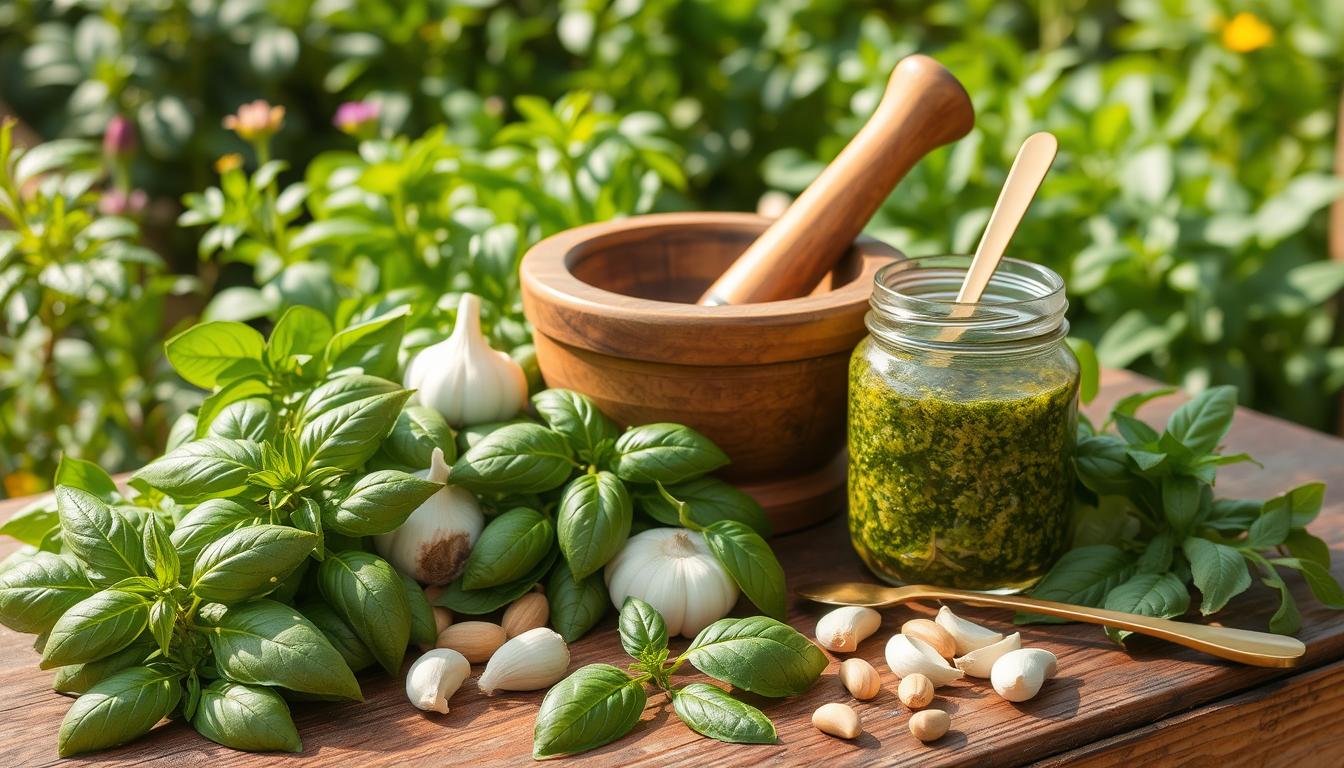This post contains affiliate links.
Ready to start a tasty journey? Your backyard is the perfect place to begin. Garden pesto, that bright green Italian sauce, is waiting to be your kitchen’s new favorite. With a few fresh ingredients and some creativity, you’ll make homemade pesto in no time.
Basil is the hero of this dish and easy to grow. It’s perfect for making that delicious basil pesto you’ve been wanting. Basil grows all season, giving you time to harvest and make your dishes. Just watch out, basil doesn’t like cold weather – it turns black at 40°F.
Homemade pesto is a hit with gardeners, and it’s simple to see why. With just 2 cups of basil, 1/2 cup of Parmesan, 1/3 cup of pine nuts, 2-4 cloves of garlic, and 1/2 cup of olive oil, you get a versatile sauce. It’s great on pasta, sandwiches, and even eggs on toast. This Italian delight will make your taste buds dance!
Key Takeaways
- Basil is an annual herb that thrives in warm temperatures
- Homemade pesto is a versatile condiment loved by gardeners
- Basic pesto recipe includes basil, Parmesan, pine nuts, garlic, and olive oil
- Pesto can be frozen for year-round enjoyment
- Regular pruning of basil plants promotes fuller growth and more flavorful leaves
The Magic of Basil: The King of Herbs
Basil is the star of herb gardens, known for its rich history and flavor. It’s called the “King” of Herbs, adding a touch of royalty to your kitchen and garden. Learn more about it here.
Nutritional Benefits of Basil
Basil is more than just a flavor enhancer. It’s packed with nutrients that fight inflammation and infections. It also helps with digestion and can even cure headaches, according to Italian folk medicine.
Varieties of Basil for Pesto
Genovese basil is a favorite in Italy, but Sweet Basil and Italian Basil are great for pesto too. Each type adds a special taste to your dishes.
| Basil Type | Flavor Profile | Best Use |
|---|---|---|
| Genovese Basil | Sweet, peppery | Traditional pesto |
| Sweet Basil | Clove-like, mild | Versatile cooking |
| Italian Basil | Anise-like, strong | Robust sauces |
Growing Basil at Home
Growing basil at home is easy. It loves warm weather but can’t handle cold. To get lots of leaves, pinch off the flowers. And watch out for July’s heat, as it can harm your basil.
“Basil: Where culinary magic meets garden charm. Grow it, love it, savor it!”
Essential Ingredients for Garden Pesto

Ready to make some delicious garden pesto? Let’s explore the pesto ingredients that will make your taste buds happy! Imagine using fragrant basil leaves, nutty pine nuts, tangy Parmesan cheese, and smooth olive oil. These ingredients are the key to a flavorful dish!
Basil is the main ingredient. You’ll need about 4 ounces of these leaves, without stems. Garlic is next, with 2-4 cloves adding a strong flavor. Then, there’s the cheese: a quarter cup each of Parmesan and Romano for that savory taste.
Pine nuts are essential for their crunch and flavor. Use ¾ to 1 cup of olive oil to mix everything together. Add ½ teaspoon of lemon juice for brightness, and season with salt and pepper.
“Pesto isn’t just a sauce; it’s a celebration of fresh ingredients!”
Want to make it even better? Try using walnuts instead of pine nuts or add some cream for creaminess. You can also add a tomato for a Sicilian twist. The secret to great pesto is using the best ingredients. So, grab your mortar and pestle (or food processor) and start making pesto!
| Ingredient | Amount |
|---|---|
| Basil | 4 oz |
| Garlic | 2-4 cloves |
| Parmesan cheese | ¼ cup |
| Romano cheese | ¼ cup |
| Olive oil | ¾ – 1 cup |
| Lemon juice | ½ tsp |
| Salt | ¾ tsp |
| Black pepper | To taste |
The Art of Making Homemade Pesto
Making your own pesto is a fun journey in the kitchen. You’ll enjoy mixing fresh ingredients to make a sauce that makes any dish better. Let’s explore how to make pesto, from old ways to new methods.
Traditional Pesto-Making Techniques
The classic way to make pesto uses a mortar and pestle. This method, used in the World Championship of Pesto, brings out deep flavors. Contestants have 30-40 minutes to make their pesto with simple ingredients.
The slow grinding process releases oils from the basil and garlic. This makes a rich, aromatic paste.
Modern Pesto Preparation Methods
Many people use a food processor or blender for quick pesto. This method makes the pesto smooth but be careful not to overdo it. Pulse the ingredients to keep some texture.
You can use different greens like arugula or spinach. Try different nuts like walnuts or almonds too.
Tips for Achieving the Perfect Consistency
The secret to great pesto is finding the right balance. Start with blanched basil to keep the color bright. Add olive oil slowly while blending for a smooth mix.
Adjust the ingredients to your liking. More cheese for creaminess, extra garlic for flavor. Remember, pesto without salt gets its flavor from cheese. Store it in freezer bags for later use.
| Ingredient | Traditional | Modern Variations |
|---|---|---|
| Greens | Genovese basil | Arugula, spinach, kale |
| Nuts | Pine nuts | Walnuts, almonds, pumpkin seeds |
| Cheese | Parmigiano Reggiano | Cheddar, feta, mozzarella |
| Method | Mortar and pestle | Food processor, blender |
Garden Pesto: A Versatile Culinary Delight
Get ready to unleash your inner chef with homemade garden pesto! This vibrant green sauce isn’t just for pasta anymore. You’ll find countless pesto uses that’ll make your taste buds dance with joy.
Let’s dive into the world of pesto possibilities. First up, the classic pasta sauce. Toss your favorite noodles with a dollop of pesto for a quick and delicious meal. But why stop there? Spread it on sandwiches for a burst of flavor or use it as a dipping sauce for veggies and bread. The options are endless!

Feeling adventurous? Try marinating chicken or fish in pesto for a zesty twist. You can even elevate your pasta dishes by adding a spoonful to your favorite recipes. Pizza lovers, rejoice! Pesto makes an excellent alternative to traditional tomato sauce.
Here’s a quick guide to inspire your pesto creations:
| Pesto Use | Preparation | Serving Suggestion |
|---|---|---|
| Pasta Sauce | Mix with hot pasta | Top with extra pine nuts |
| Sandwich Spread | Spread on bread | Layer with mozzarella and tomatoes |
| Dipping Sauce | Serve in a small bowl | Pair with crusty bread or veggie sticks |
| Pizza Topping | Spread on pizza dough | Add grilled chicken and sun-dried tomatoes |
With these ideas, you’ll never look at pesto the same way again. So grab your ingredients and start experimenting. Your taste buds will thank you!
Storing and Preserving Your Homemade Pesto
Got a lot of basil? Don’t let it go to waste! Learn how to store pesto and enjoy your garden’s bounty all year. We’ve been making pesto for 30 years and know how to keep basil delicious.
Freezing Pesto for Year-Round Enjoyment
Freeze pesto to enjoy summer flavors in winter. Our method keeps pesto fresh for years! We once found a 2014 pesto base that still tasted great. Here’s how to freeze pesto like a pro:
- Use ice cube trays for single servings
- Fill small jars for larger portions
- Top with a thin layer of olive oil to prevent oxidation
Creative Pesto Storage Solutions
Think beyond the freezer! For short-term storage, keep pesto fresh in the fridge for up to 5 days. Use airtight containers and olive oil to keep it fresh. Glass jars are better than plastic bags for flavor and safety.
Shelf Life and Safety Tips
Safety first when it comes to pesto storage! Follow these guidelines to keep your basil creation fresh and safe:
| Storage Method | Shelf Life | Tips |
|---|---|---|
| Refrigerator | Up to 5 days | Use airtight container, top with olive oil |
| Freezer | Up to 6 months | Freeze in portions, thaw in refrigerator |
| Room Temperature | 2-3 hours max | Not recommended for long-term storage |
Remember, homemade pesto beats store-bought any day. Make a small batch using a mortar and pestle at least once a summer. Your taste buds will thank you!
Unique Pesto Variations to Try
Ready to spice up your pesto? Let’s explore some tasty pesto variations that will excite your taste buds! First, we have Thai basil pesto. It’s a bold mix of Thai basil, peppers, ginger, and peanuts. It’s great for those who love a flavorful adventure.
Next, we have purple pesto. It’s made with Dark Opal or Purple Ruffles basil. This vibrant pesto not only looks amazing but also tastes unique. Add sun-dried tomatoes and rosemary, and you’ll wow your dinner guests.
For a zesty flavor, try lemon basil pesto. It combines lemon basil with almonds for a refreshing taste. It’s perfect for summer and goes well with seafood.
| Pesto Variation | Key Ingredients | Flavor Profile |
|---|---|---|
| Thai basil pesto | Thai basil, peppers, ginger, peanuts | Bold, spicy, Asian-inspired |
| Purple pesto | Dark Opal basil, sun-dried tomatoes, rosemary | Unique, robust, visually striking |
| Lemon basil pesto | Lemon basil, almonds | Citrusy, fresh, light |
Don’t be shy to try new pesto variations. Swap basil for kale or parsley, or add roasted red peppers for a smoky flavor. The world of pesto is your playground, and you might just find your new favorite dish!
Pesto Beyond Pasta: Innovative Uses in Cooking
Pesto isn’t just for pasta anymore! You’ll love exploring new ways to use this versatile sauce in your kitchen. From marinades to appetizers and even baked goods, pesto adds a burst of flavor to countless dishes.
Pesto as a Marinade
Kick your grilling game up a notch with a pesto marinade. Mix 2 cups of basil-packed pesto with lemon juice for a bright, herb-infused coating. Slather it on chicken, fish, or veggies before grilling. The result? Mouthwatering dishes bursting with garden-fresh taste.
Pesto-Infused Appetizers
Wow your guests with pesto appetizers that pack a flavor punch. Try stuffing mushrooms with a blend of pesto and breadcrumbs. Or spread pesto on crostini and top with fresh tomatoes for a quick bruschetta. For a twist, mix pesto with softened butter to create a savory spread for bread or crackers.
Pesto in Baked Goods
Think outside the box with pesto baking! Fold pesto into savory muffin batter or knead it into bread dough for a fragrant, herby loaf. You can even use it as a filling for savory pastries. The possibilities are endless when you let your creativity shine in the kitchen.
Remember, homemade pesto offers the best flavor. Use fresh basil from your garden or try variations like arugula or mint pesto. With these innovative ideas, you’ll find yourself reaching for pesto far beyond pasta night!
Health Benefits of Homemade Garden Pesto
Ready to supercharge your meals with a dollop of green goodness? Your homemade garden pesto isn’t just a flavor bomb; it’s a nutritional powerhouse! It’s packed with healthy herbs and boasts impressive pesto nutrition facts. This verdant spread is about to become your new favorite superfood.
Let’s dive into the basil benefits, shall we? A 2-tablespoon serving of your DIY pesto packs a mere 60 calories but delivers a punch of nutrients. You’ll get 2 grams of protein, 5 grams of heart-healthy fats, and a gram of fiber. Plus, it’s a sneaky way to boost your daily iron and calcium intake. Who knew eating your greens could be this delicious?
But wait, there’s more! The Mediterranean diet, which stars pesto ingredients like olive oil and nuts, is linked to lower risks of heart disease, diabetes, and even some cancers. Your homemade pesto might just be your ticket to longevity. And let’s not forget the mighty garlic – it’s not just for warding off vampires. It may help lower blood pressure and cholesterol, giving your heart a little extra love.
Ready to whip up some health in a jar? Why not pair your pesto with a fresh tomato panzanella salad for a nutritious Mediterranean feast? Just remember, if you’re storing your pesto creation, keep it chilled and use it within two weeks. After all, you wouldn’t want to miss out on all those delicious health perks!
FAQ
What is pesto?
What are the benefits of growing basil at home?
What are the different varieties of basil suitable for pesto?
How do you achieve the perfect pesto consistency?
How can pesto be used beyond pasta dishes?
What are some creative ways to store homemade pesto?
What are some unique pesto variations to try?
What are the health benefits of homemade garden pesto?
This post contains affiliate links.

